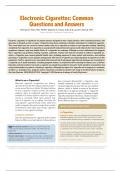Electronic Cigarettes: Common
Questions and Answers
Michael D. Klein, MD, FAAFP; Natasha A. Sokol, ScD; and Laura R. Stroud, PhD
Brown University, Providence, Rhode Island
Electronic cigarettes (e-cigarettes) are popular devices designed to heat a liquid solution, often containing nicotine, that
generates an inhaled aerosol, or vapor. e-Cigarettes have been marketed as healthier alternatives to traditional cigarettes.
Thus, most adult users are current or former smokers who use e-cigarettes to reduce or quit cigarette smoking. Switching
completely from cigarettes to e-cigarettes is associated with reduced toxicant exposure and reduced short-term respiratory
symptoms; however, long-term health effects of e-cigarettes are unknown. Although a recent randomized trial suggests
that e-cigarettes may promote smoking cessation, systematic reviews have had low certainty of evidence regarding ces-
sation. e-Cigarettes pose several potential health risks, including exposure to heavy metals and toxicants, and nicotine
poisoning. e-Cigarettes are also popular among youth, with rates of e-cigarette use surpassing those of cigarette use in this
population. Youth e-cigarette use is associated with increased risk of subsequent cigarette and marijuana use. Screening for
e-cigarette use in youth and adults, including pregnant women, in conjunction with screening for tobacco use, is advised.
Education and interventions to prevent e-cigarette use should be provided to all youth. Youth should be counseled to stop
using nicotine/tobacco products, including e-cigarettes. Although the impact of e-cigarette use in pregnancy is unknown,
nicotine is a teratogen; thus, pregnant women should be counseled to abstain from using all nicotine/tobacco products.
(Am Fam Physician. 2019;100(4):227-235. Copyright © 2019 American Academy of Family Physicians.)
What Is an e-Cigarette? have increased dramatically.1 e-Cigarettes were
Electronic cigarettes (e-cigarettes) are battery- initially marketed as safer alternatives to con-
operated devices that heat a liquid solution to gener- ventional cigarettes because they do not combust
ate an aerosol that users inhale. The liquid solution tobacco, which is linked to many of the adverse
in most e-cigarettes contains nicotine, the primary health effects of cigarette smoking.2,3 e-Cigarettes
addictive agent in traditional cigarettes, and is generate an aerosol, or vapor, by heating a liquid
available in a variety of flavors. Because e-cigarette typically composed of nicotine, a humectant (pro-
aerosol is commonly called vapor, patients may pylene glycol or glycerin), and flavorings.3 Figure 1
refer to e-cigarette use as vaping. Currently, the shows different types of e-cigarettes.4
most popular e-cigarette brand is Juul, which uses
small, rectangular flavored cartridges that resemble
WHAT IS NEW ON THIS TOPIC
a thumb drive. Most adults report using e-cigarettes
to reduce or stop cigarette smoking.
e-Cigarettes
EVIDENCE SUMMARY Among U.S. youth, rates of e-cigarette use surpassed rates of
Since the introduction of e-cigarettes in the United traditional cigarette use in 2014. In 2017, one in five U.S. high
school students reported using e-cigarettes in the previous year.
States in 2006, use of and interest in these devices
A recent meta-analysis indicated that among teens and young
adults who have never smoked, the odds of smoking initiation
CME This clinical content conforms to AAFP criteria for are three to six times greater in those who have ever used
continuing medical education (CME). See CME Quiz on e-cigarettes than in those who have never used e-cigarettes.
page 205.
The U.S. Preventive Services Task Force concludes that the
Author disclosure: No relevant financial affiliations. current evidence is insufficient to recommend e-cigarettes for
Patient information: A handout on this topic, written by the tobacco cessation in adults, including pregnant women.
authors of this article, is available at https://www.aafp.org/
afp/2019/0815/p227-s1.html. e-cigarette = electronic cigarette.
Downloaded from the
August 15, 2019 American
◆ Volume Family
100, Physician
Number 4 website at www.aafp.org/afp. Copyright © 2019 American Academy of Family
www.aafp.org/afp Physicians.
American For the
Family private, noncom-
Physician 227
mercial use of one individual user of the website. All other rights reserved. Contact copyrights@aafp.org for copyright questions and/or permission requests.
, ELECTRONIC CIGARETTES
FIGURE 1
e-Pipe e-Cigar Medium-size Rechargeable
tank device e-cigarette
Large-size “Pod mod” device Disposable
tank devices (e.g., Juul) cigarette
Examples of e-cigarette products.
Reprinted from U.S. Department of Health and Human Services. e-Cigarette use among youth and young adults. A
report of the Surgeon General. 2016. Accessed May 12, 2019. https://bit.ly/2sKHv9P; additional photo by James Gathany,
Centers for Disease Control and Prevention.
Although 99% of e-cigarettes contain nicotine, associated with a greater likelihood of smok-
teens are more likely to report using e-cigarettes ing cessation, most adults and youth do not use
for substances other than nicotine, including e-cigarettes daily.12-14 Among U.S. youth, rates of
flavors and marijuana.5,6 e-Cigarettes can be e-cigarette use surpassed rates of traditional cig-
purchased in retail stores and online and come arette use in 2014.15 In 2017, one in five U.S. high
in more than 7,000 flavors, which may increase school students reported using e-cigarettes in the
their appeal among youth and nonsmokers.7 previous year.16
Many users, especially teens and young adults, The e-cigarette brand Juul is part of the newest
refer to e-cigarettes by brand name or a slang generation of e-cigarettes called pod mods, which
term (Table 1).8-10 are rechargeable with replaceable cartridges.17
In 2016 in the United States, 15% of adults Juul’s popularity may stem from its sleek, dis-
reported any lifetime e-cigarette use, and 3% creet, and easy-to-use design, as well as its more
reported use in the previous 30 days.11 Most adult palatable nicotine solution and appealing fla-
users are current or former smokers who use vor options.17 Youth Juul users do not report
e-cigarettes to reduce or quit traditional cigarette increased e-cigarette use compared with users of
smoking.11 Although daily use of e-cigarettes is other e-cigarette brands, but Juul users are more
228 American Family Physician www.aafp.org/afp Volume 100, Number 4 ◆ August 15, 2019




